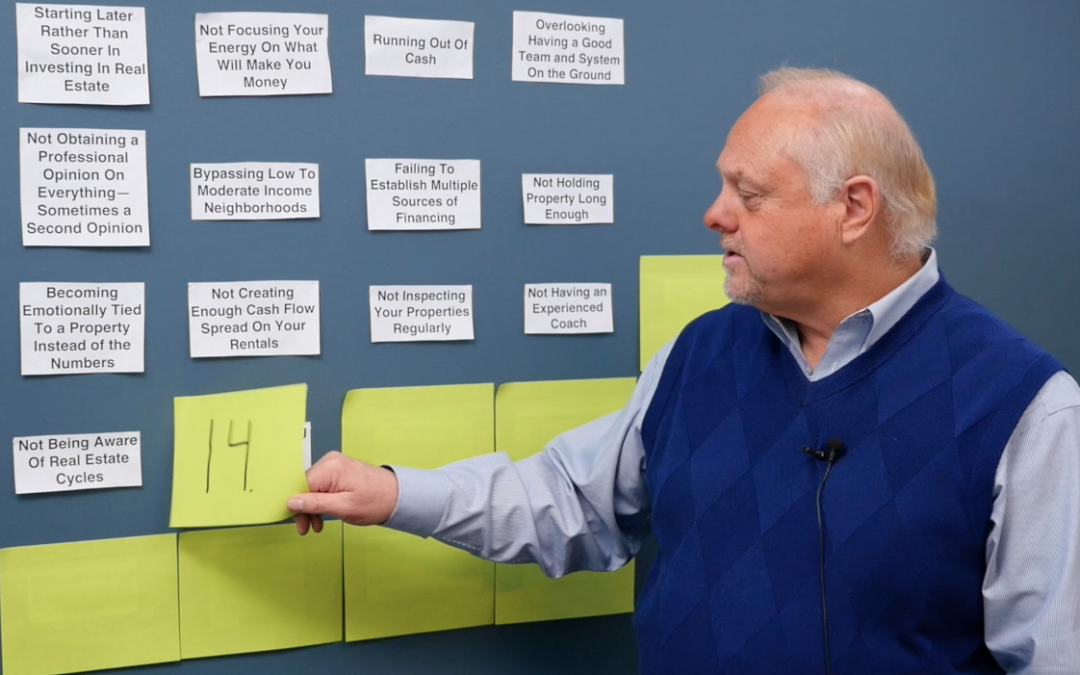Over the past month we’ve been talking about 14 mistakes new real estate investors make—and today we cover the 14th. To catch up on this series, visit my Youtube channel.
Mistake #14: Not Identifying Your Exit Strategies
This is a really common mistake. Here’s an example of what I mean. The first thing that happens is not really understanding the broad exit strategy. You have to know when you’re buying a piece of property if you’re going to buy it and flip it, buy it and rent it, or buy and rent one bedroom at a time.
To be a really successful real estate investor, you need to know how to buy and sell properly. You make money when you buy, not when you sell. In other words, you’ve got to get the proper deal going in and have the correct techniques and systems in place to sell and flip out to get a quick return on your money.
When you begin to rent, make sure you know how to manage the property or have a company do that for you.
Those are high level exit strategies. But here are specific strategies for even sophisticated investors. If I could show you how to make $100,000 tax free for the rest of your life, would you like that?
Strategy #1: Well if you bought, for example, three houses a year for ten years, you would have 30 single-family homes. In this case, we’re going to say that you have a positive cash flow of $300 cash flow per house. That means you have $9,000 a month. Multiply that by 12, and that’s $108,000.
If you take each one of those homes and depreciate them by the number the IRS allows us to depreciate properties by, then you cover all of your positive cash flow just with a phantom loss. The house doesn’t really go down in value. It continues to go up, but the IRS allows you to appreciate it about 1/27th a year on a single family house in the US. So all of your positive cash flow income is covered so you don’t owe any taxes.
When you get to the very end of it, take all of those properties you have and move them into a Charitable Remainder Trust. Or you can, before that, do a 1031 exchange on some other kind of properties to snowball up and then put it all into a Charitable Remainder Trust. When you do that, it’s very effective for not having to pay taxes.
To be clear, this is really a tax-deferred strategy. But for you in your life, it’s tax free. And for your heirs, if you put it into a trust, then it remains tax free.
Strategy #2: If you don’t want to buy 30 houses, then you can buy 20 homes. Let’s say you buy three single-family homes a year. It will take you six or seven years to do so. Then hold those for 10 years. Then you sell ten and pay off the first ten. Your renters will already have paid down the principle on those quite a lot.
Now you’ve got ten houses that are paid off. Let’s say the positive cash flow on those houses are $1000 a month. That’s $10,000 a month and you’re still getting depreciation. That’s a powerful place to be.
Strategy #3: This is another strategy that I really like. Let’s say you decide to purchase one house per year. You purchase that house, and each year for 12 years, you purchase one house. Now you have 12 houses. In year 13, you don’t buy any houses. You go back to house #1 that you bought properly (remember, you make money when you buy!). You don’t sell it, you refinance it. You pull the equity out of that house, making sure to maintain your cash flow formulas.
Let’s say you were able to take $75,000 out of that house because it had appreciated that much in 12 years. Now you take $75,000 and put it in your pocket. Do you have to pay taxes on that? No, it’s tax free. It was a loan. You borrowed it out of your house and put it in your pocket.
Now young people may think taxes aren’t a big deal. But people who are learning to live off of their money know that having $75,000 a year tax free is a major deal. A lot of people who retire with $1,000,000 in the bank think they’re going to make $100,000 a year. They end up making maybe $60,000 off the million and also pay taxes of somewhere in the 20% range. Their actual livable income is a lot less.
That’s why this is a big deal. Now I know the next year you only may take $50,000 or $60,000. But the point is it’s a good strategy if you have other forms of income in your life like social security and whatnot. We’re talking about financial independence.
I have one friend who buys as many as 10 properties a year and puts every property on a 15-year note. I remember that when he turned 55, he had a ton of really nice 3-bedroom, 2-bath brick homes that he put on a 15-year note. He let his renters pay them off and he had something like 50 of those types of properties paid off. He was renting them for about $1,400 a month. Added up, that’s $50-60,000 a month! He was still putting $30,000 a month in his pocket. I know you can live off that!
So think clearly about what you want to do with your investment and your exit strategy! These are just a couple of ideas I have used in the past. If you have any questions, please let me know in the comment section. Be sure to also share and like!
If you enjoyed this, I’ve got some bonus mistakes coming up for you next week, so stay tuned!
If you’re interested in purchasing a copy of “Money Mastery,” visit my shop to get a hard copy or amazon.com for the Kindle version. It would also mean a lot to me if you would be willing to write a review on Amazon! Thanks.
Join me every week for tips on investing in real estate.




When you talk about refi and pulling cash out that is tax free, I have a question. When you do sell that house won’t you pay tax on those dollars when calculating your profit. Still better at that point that is would a long term cap gain.